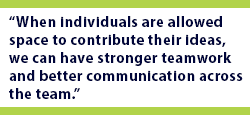
G.O.A.L.-Driven Team Meetings
By Nellie Mitchell, Granular group customer success manager
If you have ever participated in an unsuccessful team meeting, then you may want to try the G.O.A.L. method to help run an efficient team meeting.
 By Nellie Mitchell, Granular group customer success manager
By Nellie Mitchell, Granular group customer success manager
At some point, everyone has likely participated in an unsuccessful team meeting. Some meetings have a full agenda but little gets accomplished, while other meetings may not have an agenda at all and can easily get off track. We’ve probably all been frustrated when a meeting felt like a waste of time.
While it might sound nice to eliminate meetings altogether, they are necessary to stay connected, especially when working to find solutions. Since meetings will always be a staple for getting things done, let’s dive into how we can bring more efficiency to our team meetings.
We will discuss four ways to have more successful team meetings using the acronym G.O.A.L. The G.O.A.L. method can offer a quick mental checklist when determining what is needed for an efficient team meeting.
1 – GROUP: Consider who should attend and their expected roles.
We often include everyone we feel is necessary in a team meeting, but rarely do we consider what we expect from each participant. When evaluating who should attend, it may be helpful to consider what role we expect each person to play. We might need someone to be a decision maker, note taker, or facilitator, or simply contribute their ideas and experience. It is also important to review who needs to actively contribute and who simply needs to be informed. By considering the respective roles of each participant, we can respect each other’s time and improve our ability to stay on track by having the right people in attendance.
2 – OBJECTIVE: Establish a clear outcome for the meeting.
Once we have established who should attend and what their expected roles should be, we should consider the meeting objective. It may be helpful to ask ourselves, “What do we need to resolve, accomplish or decide at the end of this meeting?”
While some meetings may serve the purpose of brainstorming, without a clear objective, we often find that meetings can get off track or become inefficient. We may spend an hour in a team meeting and walk away either confused or frustrated about how the meeting contributed to the progress we intended. It is best when we can state in a simple sentence what we need to accomplish by the end of the meeting to consider it a successful use of time.
Here are a few examples of a clear meeting objective:
- Assigning responsibilities for a project or task
- Developing a workflow or system to accomplish a goal
- Deciding which solution is best for the operation or team
- Understanding the current status or pain points of the operation
3 – AGENDA: Outline an agenda and allot the necessary time to each item.
We’ve probably all heard the Benjamin Franklin quote, “If you fail to plan, you are planning to fail.” This quote is especially true in meetings. Meetings can quickly become inefficient, even when we have the best intentions. Having an agenda can be even more important in team meetings to allow time for everyone’s ideas or concerns to be heard.
 We have all likely been part of a meeting that gets off track before it even gets started. Maybe we have been a part of a team meeting where only one or two voices dominate the conversation. This is not only frustrating, but it can also send the morale of the team in a downward spiral. Creating a clear agenda and establishing a time frame for each item will not only improve efficiency, but also foster a better environment for discussion. When individuals are allowed space to contribute their ideas, we can have stronger teamwork and better communication across the team.
We have all likely been part of a meeting that gets off track before it even gets started. Maybe we have been a part of a team meeting where only one or two voices dominate the conversation. This is not only frustrating, but it can also send the morale of the team in a downward spiral. Creating a clear agenda and establishing a time frame for each item will not only improve efficiency, but also foster a better environment for discussion. When individuals are allowed space to contribute their ideas, we can have stronger teamwork and better communication across the team.
4 – LABOR: Identify what labor/work needs to be accomplished with clear action items.
Identify the action items that evolved from a meeting. Similar to the first point of establishing roles for individuals in attendance, it is equally important to assign tasks at the end of a meeting. This might seem obvious, but it is easy to wrap up a meeting without a clear plan for what is next.
Here are a few points to consider at the end of a team meeting:
- What areas are still unclear?
- What requires more information before moving forward?
- What are the time constraints for the project/issue/solution at hand?
- What topics/issues require a follow-up meeting?
- Who will be responsible for the action items that developed?
- What deadline should be in place for the action items?
- How will we communicate progress or follow up?
Whether you meet in person, online, or in the farm office before a busy day, quickly reviewing the G.O.A.L. before a meeting can improve the efficiency and communication of the meeting as well as your entire team.
| Category: |
Employee management Starting Strong - Calf Care |

